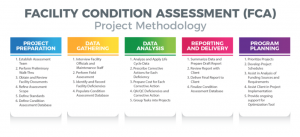Why do you need a facility conditions assessment?
Businesses need facility conditions assessments (FCA) to help prioritize preventive maintenance tasks. FCAs also help allocate future resources for improvements and preserve the remaining lifespan of critical assets. The bottom line is that an FCA is a comprehensive risk-assessment process. It takes a big-picture look at your entire facility and finds where the weak links threaten future productivity.

Prioritize Preventive Maintenance Tasks
Start with a comprehensive FCA that considers the age, condition, and performance of your critical assets. Integrate this data into your asset management planning system. The resulting preventive maintenance tasks can be scheduled as needed so that work orders are generated automatically.
Over time, maintenance technicians should record the work completed as well as issues that arise. The ongoing monitoring of key assets will give management a clearer picture of the overall condition of the asset. The cost and frequency of preventive maintenance tasks can be analyzed and compared with the cost of a replacement down the road.
Allocate Resources for Capital Improvements
An FCA gives an organization the opportunity to step back and re-evaluate its mission and goals. Evaluate your assets in an FCA. Then, consider how each asset impacts your business’ ability to deliver its products and services to customers. Through this process, it should become clear which assets are critical and which are secondary.
You may want to develop a numeric scoring scale to evaluate your assets. This can help you prioritize both preventive maintenance and timing for potential replacement. The data should help management forecast capital improvements needed over the next five to 10 years.
Preserve Remaining Lifespan of Critical Assets
Put into practice a preventive or predictive maintenance program based on the results uncovered by your FCA. This will reduce downtime and emergency repairs as well as help you extend the life of your current assets. Each year you can avoid a major capital expenditure means more revenue for your bottom line.
Want to keep reading?
What is a Facility Condition Assessment?
Facility Condition Assessment
What Is Planned Maintenance? | 6 Benefits & Workflow
4,000+ COMPANIES RELY ON ASSET OPERATIONS MANAGEMENT
Leading the Way to a Better Future for Maintenance and Reliability
Your asset and equipment data doesn't belong in a silo. UpKeep makes it simple to see where everything stands, all in one place. That means less guesswork and more time to focus on what matters.

![[Review Badge] Gartner Peer Insights (Dark)](https://www.datocms-assets.com/38028/1673900494-gartner-logo-dark.png?auto=compress&fm=webp&w=336)
